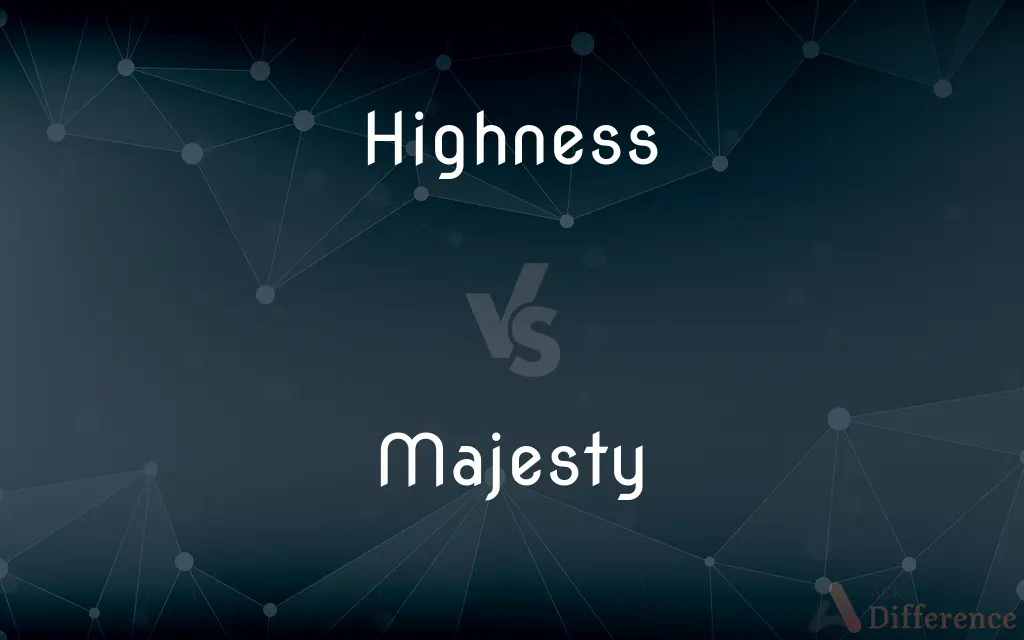Highness vs. Majesty — What's the Difference?
By Urooj Arif & Maham Liaqat — Updated on March 8, 2024
Highness is a title of nobility, often used for princes and princesses, while Majesty denotes higher royalty like kings and queens.

Difference Between Highness and Majesty
Table of Contents
ADVERTISEMENT
Key Differences
Highness is a style or title used to address or refer to some members of a royal family, typically those not at the very top of the succession line, such as princes and princesses. It conveys respect and the elevated status of the individual within the nobility. On the other hand, Majesty is reserved for kings, queens, and emperors, signifying the highest level of respect and the supreme status of these sovereign figures in a monarchy.
The use of "Highness" can vary depending on the country's specific titles and honorific systems, with some nations having variations like "Royal Highness" or "Serene Highness" to denote different ranks or statuses within the royal family. Conversely, "Majesty" is universally recognized as pertaining to the sovereign ruler or a queen consort, without such gradations in its application.
The distinction between these titles reflects the hierarchical structure of royal and imperial families, with "Majesty" signifying the paramount authority of a monarch. In contrast, "Highness" acknowledges the nobility without implying sovereign power. This differentiation helps in delineating the immediate ruling monarch from other members of the royal family.
In terms of protocol and etiquette, addressing a royal figure by their correct title is crucial. "Your Majesty" is used when speaking directly to a king or queen, reflecting their supreme position. Meanwhile, "Your Highness" is the appropriate form of address for princes and princesses, indicating a high but not sovereign rank within the royal hierarchy.
Despite these differences, both titles emphasize the dignity, respect, and elevated status accorded to members of the royalty, underscoring the traditional reverence for monarchy and nobility in societies that maintain these systems.
ADVERTISEMENT
Comparison Chart
Usage
For princes and princesses
For kings, queens, and emperors
Signifies
Elevated status within nobility
Supreme status and sovereignty
Variations
"Royal Highness," "Serene Highness"
Generally no variations
Historical Role
Denotes nobility without sovereign power
Signifies paramount authority of a monarch
Protocol
Addressed as "Your Highness"
Addressed as "Your Majesty"
Compare with Definitions
Highness
Often varies to indicate specific ranks within the royalty.
His Serene Highness was known for his contributions to the arts.
Majesty
Indicates the highest level of respect and royal authority.
His Majesty decreed a national day of celebration.
Highness
Used in formal and diplomatic contexts to address or refer to royalty.
The ambassador presented his credentials to Their Highnesses.
Majesty
Embodies the supreme dignity and status of the monarch.
Majesty's government outlined the new legislative agenda.
Highness
Denotes a noble status without implying ruling authority.
Her Highness attended the charity event in the city.
Majesty
A title used to address or refer to a sovereign ruler or queen consort.
All stood as Her Majesty, the Queen, entered the room.
Highness
Reflects the respect and reverence accorded to nobility.
The announcement of Her Highness's visit excited the local community.
Majesty
Universal across monarchies, without variations for rank.
The foreign dignitaries were granted an audience with His Majesty.
Highness
A title of respect used for members of a royal family beneath the monarch.
The delegation was received by His Royal Highness, the Prince.
Majesty
Central to the protocol in interactions with the sovereign.
The letter was addressed to Her Majesty, Queen Elizabeth II.
Highness
Highness (abbreviation HH, oral address Your Highness) is a formal style used to address (in second person) or refer to (in third person) certain members of a reigning or formerly reigning dynasty. It is typically used with a possessive adjective: "His Highness", "Her Highness" (HH), "Their Highnesses", etc.
Majesty
Majesty (abbreviated HM for His Majesty or Her Majesty, oral address Your Majesty; from the Latin maiestas, meaning "greatness") is used as a manner of address by many monarchs, usually kings or queens. Where used, the style outranks the style of (Imperial/Royal) Highness, but was formerly inferior to the style of Imperial Majesty.
Highness
The quality or condition of being high.
Majesty
Sovereign power, dignity, or grandeur
The majesty of the royal couple.
Highness
Highness Used with His, Her, or Your as a title and form of address for a prince or princess
Her Royal Highness the Princess Margaret.
Majesty
Supreme authority or power
The majesty of the law.
Highness
The state of being high.
Majesty
A royal personage.
Highness
A title of respect when referring to a prince or princess.
Majesty
Majesty Used with His, Her, or Your as a title and form of address for a sovereign.
Highness
The state of being high; elevation; loftiness.
Majesty
Magnificence or splendor
The majesty of the Rockies.
Highness
A title of honor given to kings, princes, or other persons of rank; as, His Royal Highness.
Majesty
The quality of being impressive and great.
The majesty of the Great Pyramids
Highness
(Your Highness or His Highness of Her Highness) title used to address a royal person
Majesty
The dignity and authority of sovereign power; quality or state which inspires awe or reverence; grandeur; exalted dignity, whether proceeding from rank, character, or bearing; imposing loftiness; stateliness; - usually applied to the rank and dignity of sovereigns.
The Lord reigneth; he is clothed with majesty.
No sovereign has ever represented the majesty of a great state with more dignity and grace.
Highness
The condition of being high or lofty
Majesty
Hence, used with the possessive pronoun, the title of an emperor, king or queen; - in this sense taking a plural; as, their majesties attended the concert.
In all the public writs which he [Emperor Charles V.] now issued as King of Spain, he assumed the title of Majesty, and required it from his subjects as a mark of respect. Before that time all the monarchs of Europe were satisfied with the appellation of Highness or Grace.
Majesty
Dignity; elevation of manner or style.
Majesty
Impressiveness in scale or proportion
Common Curiosities
Do any countries use titles other than "Highness" or "Majesty" for royalty?
Yes, some countries have unique titles for their royalty, but "Highness" and "Majesty" are among the most universally recognized.
Can someone be addressed with both "Highness" and "Majesty"?
Generally, a royal is addressed by the highest title applicable to them, so they would not be addressed with both titles simultaneously.
Can "Majesty" and "Highness" be used interchangeably?
No, these titles are not interchangeable and are used based on the royal individual's rank and sovereignty.
What determines if someone is addressed as "Highness" or "Majesty"?
The individual's position within the royal family and the specific titles designated by their monarchy determine the appropriate address.
Has the use of "Highness" or "Majesty" evolved over time?
Yes, the usage and significance of these titles have evolved, reflecting changes in societal attitudes towards monarchy and nobility.
Is there a hierarchy within the titles of "Highness" and "Majesty"?
"Majesty" is higher in the hierarchy, denoting sovereign rulers, while "Highness" is used for other members of the royal family.
Can titles like "Highness" or "Majesty" be revoked?
In some cases, monarchies or governing bodies can revoke these titles, usually due to legal or familial decisions.
How do members of the public address letters to "Highness" or "Majesty"?
Letters to royalty start with "Your Highness" or "Your Majesty" and end with a respectful closing, such as "Yours faithfully."
Are there educational programs or resources for understanding royal titles?
Yes, several institutions and historical societies offer resources and training on royal protocols and the history of monarchy.
Are there specific ceremonies for addressing someone as "Highness" or "Majesty"?
Formal protocols exist for addressing royalty, often observed during official ceremonies or state functions.
How does one become accustomed to royal protocols involving these titles?
Learning and observing formal etiquette, often through diplomatic training or guidance from protocol offices, can familiarize individuals with the correct usage of these titles.
Do these titles convey any specific powers or privileges?
While these titles reflect status and respect, the actual powers or privileges are determined by the laws and customs of each monarchy.
Can non-royal individuals receive titles like "Highness" or "Majesty"?
Traditionally, these titles are reserved for royalty, but honorary titles may be bestowed in exceptional cases.
What is the significance of "Royal Highness" versus "Serene Highness"?
These variations denote different ranks or statuses within royal families, with "Royal Highness" often implying a closer relation to the sovereign.
How do media and official documents refer to individuals with these titles?
Media and official documents use "Highness" or "Majesty" when referring to royals, adhering to formal protocols of respect and etiquette.
Share Your Discovery

Previous Comparison
Motrin vs. Ibuprofen
Next Comparison
Sambo vs. WrestlingAuthor Spotlight
Written by
Urooj ArifUrooj is a skilled content writer at Ask Difference, known for her exceptional ability to simplify complex topics into engaging and informative content. With a passion for research and a flair for clear, concise writing, she consistently delivers articles that resonate with our diverse audience.
Co-written by
Maham Liaqat















































